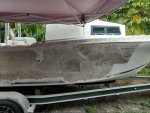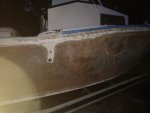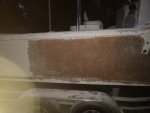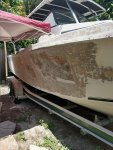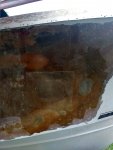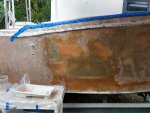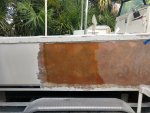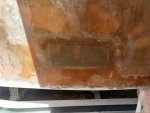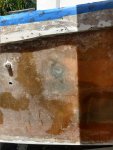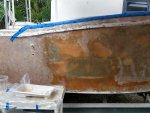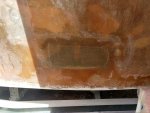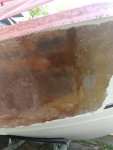You're actually very lucky you still have a boat... Polyester resin is a thermoset plastic versus a thermoplastic... Difference being, thermoset doesn't melt, it just burns... If your boat got hot enough to actually ignite, you'd have nothing but a pile of ashes.
Your repair is going to be a tricky one and something that probably isn't documented too well here. My concern would be that the entire laminate on the one side of the boat has been structurally compromised. It would seem that the fix would be to grind down to "fresh glass", however, I'm not sure there is any "fresh glass". My first thought would be to grind down until you only have a layer or two of laminate left and basically rebuild that side of the boat, however, I would be concerned that if you grind too much off of the side of the boat along its whole length, you may risk the whole side of the hull collapsing or buckling under its own weight. It may not fail altogether, but you may end up with a wavy hull that dips and rises based on the underlying structure (stringers/bulkheads/deck/etc...).
Another thought that crossed my mind was just grind off the gelcoat and any blisters or defects and just build on top of the existing laminate with the assumption that it is no good and build up several layers to the original thickness of the hull on top of the old.... That is not a good idea, because you are going to add a ton of weight to one side of the boat and it will never sit even-keeled in the water.
The best thing I could think of is to grind down to the last layer or two of the hull in sections and do sections at a time and then maybe do the last layer or two the full length to tie it all together.
One other thing worth mentioning is, I would not be hell-bent on finishing the repairs with gelcoat. Planning to paint at this point is going to greatly open up the availability of what you can use in your repairs. If you want to finish with gelcoat, you will need to stick with all polyester based materials which eliminates a lot of fairing compounds. Not to mention, unless you plan to buy a dump gun setup and have a large air compressor, rolling or brushing gelcoat will leave you a years worth of sanding...
If you paint, you can use a good 2 part topside paint with rolling and tipping and have much much less sanding to do...
Hope some of that input was useful, do your research, decide what you want to do, and we will be here to guide you along the way. Good luck!























